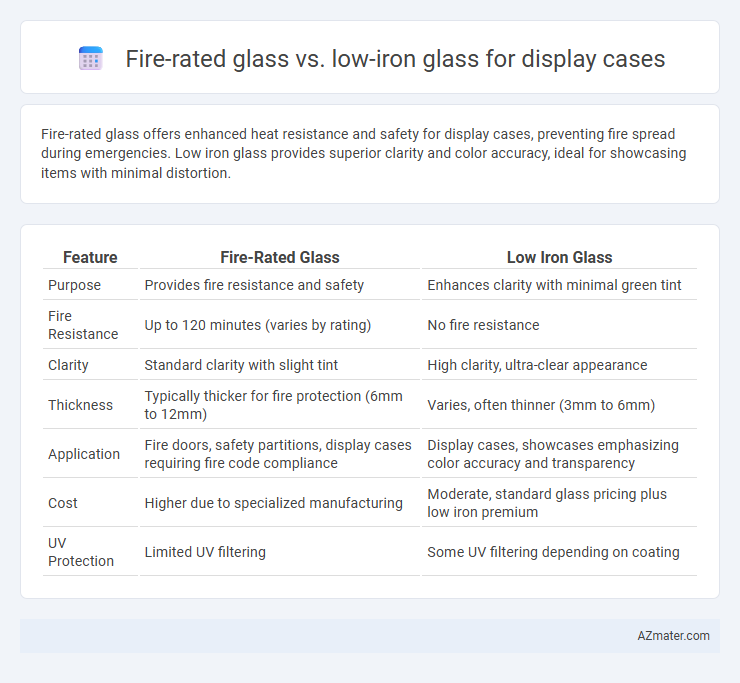Fire-rated glass offers enhanced heat resistance and safety for display cases, preventing fire spread during emergencies. Low iron glass provides superior clarity and color accuracy, ideal for showcasing items with minimal distortion.
Table of Comparison
| Feature | Fire-Rated Glass | Low Iron Glass |
|---|---|---|
| Purpose | Provides fire resistance and safety | Enhances clarity with minimal green tint |
| Fire Resistance | Up to 120 minutes (varies by rating) | No fire resistance |
| Clarity | Standard clarity with slight tint | High clarity, ultra-clear appearance |
| Thickness | Typically thicker for fire protection (6mm to 12mm) | Varies, often thinner (3mm to 6mm) |
| Application | Fire doors, safety partitions, display cases requiring fire code compliance | Display cases, showcases emphasizing color accuracy and transparency |
| Cost | Higher due to specialized manufacturing | Moderate, standard glass pricing plus low iron premium |
| UV Protection | Limited UV filtering | Some UV filtering depending on coating |
Introduction to Display Case Glass Options
Fire-rated glass offers essential safety features by withstanding high temperatures and preventing fire spread, making it ideal for display cases in public or commercial environments requiring strict fire codes compliance. Low iron glass is prized for its exceptional clarity and minimal green tint, ensuring vibrant and true color representation of showcased items in display cases, especially in galleries or retail settings. Both options cater to distinct needs, balancing safety with aesthetic presentation depending on the display case's purpose and location.
Understanding Fire-Rated Glass
Fire-rated glass is designed to withstand high temperatures and prevent the spread of flames and smoke, making it essential for safety in display cases located in public and commercial spaces. This type of glass typically contains special interlayers or coatings that enhance its fire resistance without compromising visibility. In contrast, low iron glass prioritizes clarity and color accuracy, but lacks the fire protection properties necessary for compliance with fire safety regulations.
What is Low Iron Glass?
Low iron glass is a high-clarity glass variant with reduced iron content, resulting in minimal greenish tint and enhanced light transmission compared to standard glass. Its superior transparency makes it ideal for display cases where accurate color representation and unobstructed viewing are critical. While fire-rated glass prioritizes heat resistance and safety during fire incidents, low iron glass focuses primarily on aesthetic quality and visual performance.
Key Differences: Fire-Rated vs Low Iron Glass
Fire-rated glass for display cases is designed to withstand high temperatures and prevent the spread of fire, providing crucial safety compliance and protection in emergency situations. Low iron glass offers superior clarity and enhanced light transmission, making it ideal for showcasing items with minimal color distortion but lacks fire-resistant properties. Key differences include fire protection capability in fire-rated glass versus optical clarity and aesthetics in low iron glass, influencing choice based on safety requirements versus display quality.
Safety and Code Compliance Considerations
Fire-rated glass for display cases meets stringent fire safety codes by providing heat resistance and preventing flame spread, essential for protecting valuable items during emergencies. Low iron glass, while offering superior clarity and aesthetic appeal, lacks the fire-resistant properties required for compliance with fire safety regulations. Prioritizing fire-rated glass ensures adherence to building codes and maximizes user safety in environments where fire protection is critical.
Clarity and Aesthetic Impact
Fire-rated glass offers essential safety by withstanding high temperatures but compromises slightly on clarity due to its multiple protective layers, often resulting in a slight tint or distortion. Low iron glass provides superior optical clarity with minimal greenish hue, enhancing the aesthetic impact of display cases by delivering true-to-life color representation and sharper visuals. For high-end displays prioritizing visual appeal, low iron glass is preferred, whereas fire-rated glass is crucial for safety in hazardous or regulated environments.
Durability and Maintenance Factors
Fire-rated glass offers superior durability by withstanding high temperatures and preventing fire spread, making it ideal for safety-critical display cases. Low iron glass provides enhanced clarity and aesthetic appeal but is less resistant to thermal stress and impact, requiring more careful handling and maintenance. Maintenance of fire-rated glass typically involves routine inspections for cracks or damage, whereas low iron glass demands regular cleaning to maintain its visual transparency and avoid surface scratches.
Cost Comparison: Fire-Rated vs Low Iron Glass
Fire-rated glass typically costs 2 to 3 times more than low iron glass due to its specialized construction and fire-resistant properties. Low iron glass offers higher clarity and aesthetics at a lower price point, making it a cost-effective option for display cases that do not require fire protection. Budget considerations often lean towards low iron glass for standard displays, while fire-rated glass is essential and justified only in compliance-driven environments.
Ideal Applications for Each Glass Type
Fire-rated glass is ideal for display cases requiring fire protection and compliance with safety codes in commercial or public buildings, such as museums, retail stores, and airports, ensuring visibility while slowing fire spread. Low iron glass is best suited for high-end display cases where clarity and true color rendition are critical, like art galleries, jewelry stores, and luxury retail environments. Choosing between fire-rated and low iron glass depends on prioritizing safety regulations versus optical performance for the specific display case application.
Choosing the Right Glass for Your Display Case
Selecting the ideal glass for your display case depends on safety requirements and visual clarity. Fire-rated glass offers heat resistance and prevents the spread of flames, making it essential for protective enclosures in fire-prone areas. Low iron glass provides superior transparency and color accuracy, enhancing the visibility and aesthetic appeal of showcased items in museums or retail displays.

Infographic: Fire-rated glass vs Low iron glass for Display case
 azmater.com
azmater.com